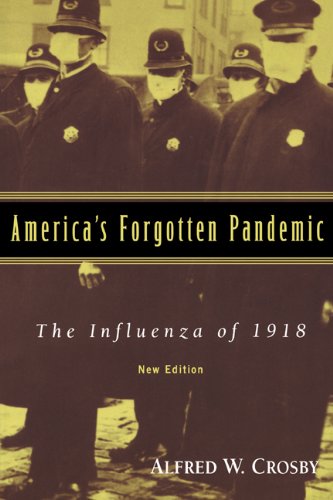(on Alfred W. Crosby, America’s Forgotten Pandemic: The Influenza of 1918, Cambridge University Press, 2003; originally published as Epidemic and Peace, 1918. Greenwood Press 1976)The Spanish Flu of 1918 seems to be, at least in the American press, the most commonly invoked historical comparison and the place where lessons for Covid-19 can be found for social and health measures, the importance of public trust and transparency, as well as projecting economic fallout from social distancing and disease. This surprised me because this pandemic occurred over a century ago in the midst of war, at a time when epidemiology was not quite a profession, and when many public health initiatives and agencies did not exist in the capacity we have today, however underfunded and underprepared we find them now.This book is certainly not a “global history” of the Spanish Flu, but elements of both book titles shine through. Crosby finds that the epidemic was so connected to the war effort that it was difficult both in the moment and in later memory and history to separate the two, leading to the history of the war, the public focus of the war effort, and the wartime losses to supersede perceptions and historical accounting of the flu. An exception is the scientific efforts and advancements that focused funding and efforts on influenza in the decades following 1918. The new title, America’s Forgotten Pandemic was useful in rebranding it. The book was originally published as one of the first major histories of the Spanish Flu but sales and interest suffered from the perception that advances in hygiene, penicillin, and vaccines seemed to relegate pandemics to history. There was a brief swine flu scare in the year of original publication, 1976, but Crosby writes in the prologue to the new edition that it wasn’t until SARS in 2002/2003 that there was new interest in the topic of pandemics and their histories. Of course, the current moment is why this title ends up on my reading list in 2020.The author recounts, among other, the details for the early response in the US, i.e. when the public and government began to take note and action; the response and advances in the scientific community from prior to the pandemic (starting with the late 19th century), focusing on the critical years around 1918 and ending in the 1930s; and the memory or lack thereof among the public and governing institutions, which he claims is not a lack of memory among the local populations but rather that these personal memories were neither recorded nor deemed by institutions and individuals to be as consequential as the war effort.In the chapter, which addresses the public taking notice, there are many parallels to the current moment to be found. The effects of the illness were largely generational, in the Spanish flu killing young rather than old. The primary location where influenza spread remains the same: military camps and ships, prisons, factories, and at large events. States and local areas fractured and bid against one another for supplies (in 1918, the hottest commodity was a nurse, not a ventilator). Conspiracy theories and nationalism was rampant, linking the disease with the war effort (a German plot). Major volunteer efforts in multiple sectors filled gaps in the system. This book, not written for the current moment, contrasts with the lessons most current historians have been filling the press with: how social distancing worked in the cities that enacted it and how economies suffered in the years to come in cities that didn’t enact these measures, which I did not see in this book.In terms of scientific advancements, one lesson from 1918 that the author stresses, but I haven’t seen historians address in the media, is the history of the search for a vaccine. In 1918, that meant first a search for the cause, which proved problematic. Bacteria are larger and microscopes in 1918 were not strong enough to see smaller viruses. Many scientists thought that influenza was bacterial as swabs made bacterial cultures visible and not viruses. The author warns that the human trials for the Spanish Flu epidemic were so wildly unsuccessful, largely because it was impossible in the middle of that episode to create any controlled study, i.e. to know for sure if the trial participants had already been exposed to the flu and would therefore not contract the illness in trials or whether the trial itself was unsuccessful. With so many invisible carriers of the Coronavirus and no antibody test, is it wise for companies like Moderna to skip animal testing and move directly to human trials, including in areas already impacted by the pandemic? On a side note, a wonderful story in the book is how dog lovers in England were tricked into funding an excellent state of the art trial to find an ultimately successful vaccine for dog distemper. This facility and the knowledge gained from this virus and vaccine led to the breakthrough that would uncover more about influenza.In the final chapter on memory, Crosby writes:“Americans barely noticed and didn’t recall—that is exasperatingly obvious to anyone examining the histories, popular magazines, newspapers, and political and military memoirs of the World War I era—but if one turns to intimate accounts, to autobiographies of those who were not in positions of authority, to collections of letters written by friend to friend and husband to wife in the fall of 1918, and, especially, if one asks those who lived through the pandemic for their reminiscences, then it becomes apparent that Americans did notice, Americans were frightened, and courses of their lives were deflected into new channels, and that they remember the pandemic quite clearly and often acknowledge it as one of the most influential experiences of their lives.” (P. 323).The sources he uses for most of the book are local newspapers, annual reports of governmental and medical agencies, and medical journals. In the final chapter, he closes his account with the few memoirs and works of fiction that address the experience. In the current news cycle on Covid-19, news stories reflecting on 1918 use recorded oral histories of the pandemic. These mostly didn’t exist when Crosby wrote this book. These were collected by local libraries and archives across the country as separate projects in the 1980s (For example, these oral histories in Kentucky are collected in the 1980s and early 1990s: Kentucky Oral History Project, „Influenza Epidemic, 1918-1919“ / See also: Southern Oral History Project at the University of North Carolina)That new material marked a turn to make history from below possible for historians, and indeed these oral histories do demonstrate, beyond the statistics that Crosby collected, how deep this experience impacted American history and family, work, health, and nearly all social experiences of 1918 and the decades to follow.As I already remarked, the research on 1918 is largely a national history or local history, and this book in no exception. The sources available lend themselves to these local studies. In 2012, archivists and historians of Medicine at the University of Michigan built a digitized Influenza Encyclopedia to collect digitized sources of the epidemic across the US, including private letters, newspaper articles, and annual reports. It is an impressive collection of local histories (Influenza Encyclopedia). Notably, this encyclopedia does not reference any American colonies/territories during the epidemic or collect any local newspapers from them. But what about efforts in the here and now to understand the novel Coronavirus? Will historians in years to come have better, diverse sources and what efforts are underway now to collect them? There are a number of surveys from social science institutes. One Welsh artist and archivist, out of a job, has solicited on Twitter to create a global archive of everyday experiences during the pandemic, asking participants from around the world to actively reflect on their time now in a series of video recordings (Scott Simon, “Welsh Archivist Documents Ordinary People in Extraordinary Times”, March 21, 2020, National Public Radio) It seems like an effort to understand how people who are often not captured in national archives experience something as global as this pandemic and the resulting effects in their individual lives as it is actually unfolding, unlike the reflective 1918 oral history projects. Will it be the start of a truly global archive of everyday lives? What other sources are we creating?

